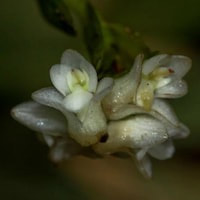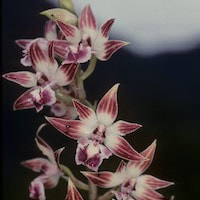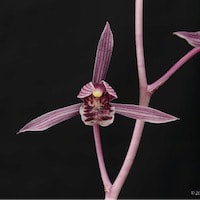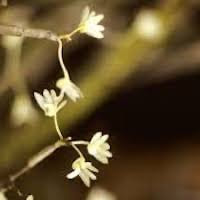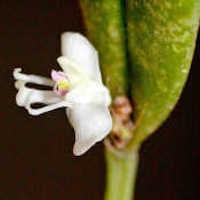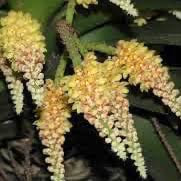WOR1 - Women's Oriental 1 - Spice, spice baby
|
Native Singaporean Orchid notes: Arachnis Hookeriana
Arachnis Hookeriana, or Hooker's Arachnis, is a native orchid known for its striking scorpion-shaped flowers and musky fragrance. Thriving in sunny environments, it grows as an epiphyte or lithophyte in coastal regions of Singapore, Borneo, Peninsular Malaysia, and Vietnam. This orchid's distinct scent makes it valuable in perfumery, contributing depth to fragrances. Used in events like Oriental 1 for team-building perfume workshops, its captivating aroma adds sophistication and allure, appealing to both perfumers and enthusiasts seeking unique fragrance compositions.
|
Therapeutic Orchid notes:
|
Appendicula cornuta Blume
Appendicula cornuta Blume, known as Horned Appendicula, is an orchid species found across Southeast Asia, including India and China. It holds significance in traditional medicine, particularly in Indonesia, where its stem-juice is used to treat "whitlow," a painful bacterial infection on fingers or toes. The orchid contains alkaloids, compounds known for their medicinal properties, making it valued in local folk medicine. While its traditional uses are documented, more scientific research is needed to confirm its efficacy and safety in modern medical practices. |
|
Calanthe brevicornu Lindl. Syn. Calanthe lamellosa Rolfe
Calanthe brevicornu, also known as Calanthe lamellosa or "kidney lips prawn spine orchid" in Chinese (Shenchunxiaji Lan), is valued in Traditional Chinese Medicine (TCM) for its root's medicinal properties. It is used to cool the body and treat conditions associated with heat, promote urine production to eliminate toxins, and reduce bleeding and swelling. In TCM, it addresses nephritis and urinary issues and aids in delivering the placenta and recovering from stillbirth. Beyond its medicinal uses, its fragrant cinnamon-like flowers bloom from May to June, enhancing its appeal as both a therapeutic herb and ornamental orchid across regions from northeast India to various provinces in China. Despite its traditional use, further scientific research is needed to confirm its effectiveness and safety for modern medical applications. |
|
Cymbidium sinense (Jacks.) Willd. Syn. Cymbidium chinense Heynh.
Cymbidium sinense, also known as Cymbidium chinense, is a culturally significant orchid in China, celebrated under festive names like Baisui Lan (New Year Greeting Orchid), Baosui Lan (Congratulations for the New Year), Chun Lan (Spring Orchid), and Mo Lan (Dark Orchid). This orchid thrives across India, Myanmar, northern Thailand, Vietnam, eastern China, and Japan's Ryukyu Islands, blooming from October to March in China. It's cherished for its beauty and utilized in Traditional Chinese Medicine (TCM) for its roots' medicinal properties, which are used to treat respiratory issues like coughs and asthma. While valued in traditional practices, further scientific research is needed to confirm its effectiveness and safety in modern medicine. |
|
Dendrobium herbaceum Lindl.
Dendrobium herbaceum Lindl., also known as "grass Dendrobium" or "Sasanga" in Orissa, is a unique orchid species native to southern India, extending from the Western Ghats to Orissa, Bangladesh, and the Andaman Islands. It is notable for its small flowers compared to others in its genus. Chemical analysis has identified flavonoids, sugars, cyanogenic glycosides, and tannins in its leaves, but their specific roles and structures require further investigation. In traditional Indian herbal medicine, a paste made from its leaves and Andrographis paniculata shoots is applied to treat syphilitic ulcers, a type of skin ulcer linked to syphilis. This usage reflects indigenous knowledge, underscoring the need for scientific validation of its medicinal properties for broader application in modern medicine. |
|
Dendrobium trigonopus Rchb. f.
Dendrobium trigonopus Rchb. f., known as "Uang kham pak kai" and "Uueang kham liam" in Thai, is a fragrant orchid species found in northern Thailand, Myanmar, southern Yunnan (China), and Laos, often growing on trees in sparse woodlands. It contains Trigonopol A, a compound that shows promise for its ability to prevent abnormal blood clotting, important for managing cardiovascular conditions. In Thai herbal medicine, the orchid's stem is used to treat fever and anemia, reflecting local traditions. Scientific studies are needed to fully understand its medicinal benefits and safety for broader medical use. |
|
Pomatocalpa spicatum Breda, Kuhl & Hasselt. syn. Pomatocalpa wendlandorum (Rchb.f.) J.J. Sm
Pomatocalpa spicatum, also known as Pomatocalpa wendlandorum, is an orchid species valued for its unique fragrance and traditional medicinal role. It thrives across regions from central Bhutan and Sikkim to Myanmar, Thailand, Malaysia, and Indonesia, typically growing at altitudes up to 700 meters. Among the Nicobarese people in the Bay of Bengal islands, this orchid has been historically used in traditional medicine to treat fits or convulsions, known as seizures. This traditional practice reflects local wisdom in utilizing natural remedies, yet further scientific research is needed to validate its effectiveness and safety for treating such conditions. Seeking guidance from healthcare professionals is advised for appropriate management of health concerns like seizures. |
Other scent note
Spicy notes of Clove, Anise, Pepper, Vanilla, Leather, Balsam, Warm musk combination, Suede, Caviar, Ginseng
Scentopia Library Reference ingredient
Carnation - Check details at Scentopia's scent library
Download the guided mediation that works best with this Orchid fragrance oil
| women_oriental_essential_oil_orchi_00001.mp3 | |
| File Size: | 19685 kb |
| File Type: | mp3 |

